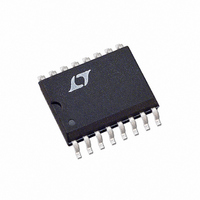LTC1264-7CSW#TRPBF Linear Technology, LTC1264-7CSW#TRPBF Datasheet - Page 12

LTC1264-7CSW#TRPBF
Manufacturer Part Number
LTC1264-7CSW#TRPBF
Description
IC FILTER 8TH ORDR LOWPASS16SOIC
Manufacturer
Linear Technology
Datasheet
1.LTC1264-7CN.pdf
(16 pages)
Specifications of LTC1264-7CSW#TRPBF
Filter Type
Linear Phase, Lowpass Switched Capacitor
Frequency - Cutoff Or Center
200kHz
Number Of Filters
1
Max-order
8th
Voltage - Supply
±2.375 V ~ 8 V
Mounting Type
Surface Mount
Package / Case
16-SOIC (0.300", 7.5mm Width)
Order Filter (max)
8th
Single Supply Voltage (typ)
5/9/12/15V
Dual Supply Voltage (typ)
±3/±5V
Power Supply Requirement
Single/Dual
Single Supply Voltage (min)
4.75V
Single Supply Voltage (max)
16V
Dual Supply Voltage (min)
±2.375V
Dual Supply Voltage (max)
±8V
Operating Temperature (min)
-40C
Operating Temperature (max)
85C
Package Type
SOIC W
Lead Free Status / RoHS Status
Lead free / RoHS Compliant
Clock Feedthrough
Clock feedthrough is defined as the RMS value of the clock
frequency and its harmonics that are present at the filter’s
output pin (9). The clock feedthrough is tested with the
input pin (2) grounded and it depends on PC board layout
and on the value of the power supplies. With proper layout
techniques the values of the clock feedthrough are shown
in Table 8.
LTC1264-7
A
Table 8. Clock Feedthrough
Note: The clock feedthrough at 25:1 is imbedded in the wideband
noise of the filter. Clock waveform is a square wave.
Any parasitic switching transients during the rise and fall
edges of the incoming clock are not part of the clock
feedthrough specifications. Switching transients have fre-
quency contents much higher than the applied clock; their
amplitude strongly depends on scope probing techniques
as well as grounding and power supply bypassing. The
12
PPLICATI
V
Single 5V
±5V
±7.5V
S
O
U
100µV
100µV
120µV
S
25:1
RMS
RMS
RMS
I FOR ATIO
U
1000µV
W
100µV
400µV
50:1
RMS
RMS
RMS
U
clock feedthrough, if bothersome, can be greatly reduced
by adding a simple R/C lowpass network at the output of
the filter pin (9). This R/C will completely eliminate any
switching transients.
Wideband Noise
The wideband noise of the filter is the total RMS value of
the device’s noise spectral density and it is used to
determine the operating signal-to-noise ratio. Most of its
frequency contents lie within the filter passband and it
cannot be reduced with post filtering. For instance, the
LTC1264-7 wideband noise at ±5V supply is 160µV
145µV
to the filter’s cutoff frequency. The total wideband noise
(µV
The clock feedthrough specifications are not part of the
wideband noise.
Speed Limitations
To avoid op amp slew rate limiting at maximum clock
frequencies, the signal amplitude should be kept below a
specified level as shown in Table 9.
RMS
RMS
) is nearly independent of the value of the clock.
of which have frequency contents from DC up
12647fa
RMS
,












